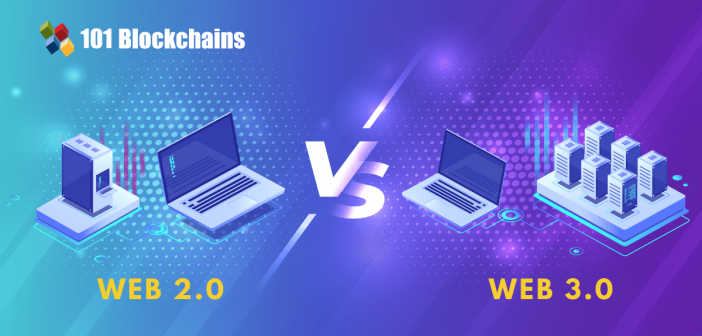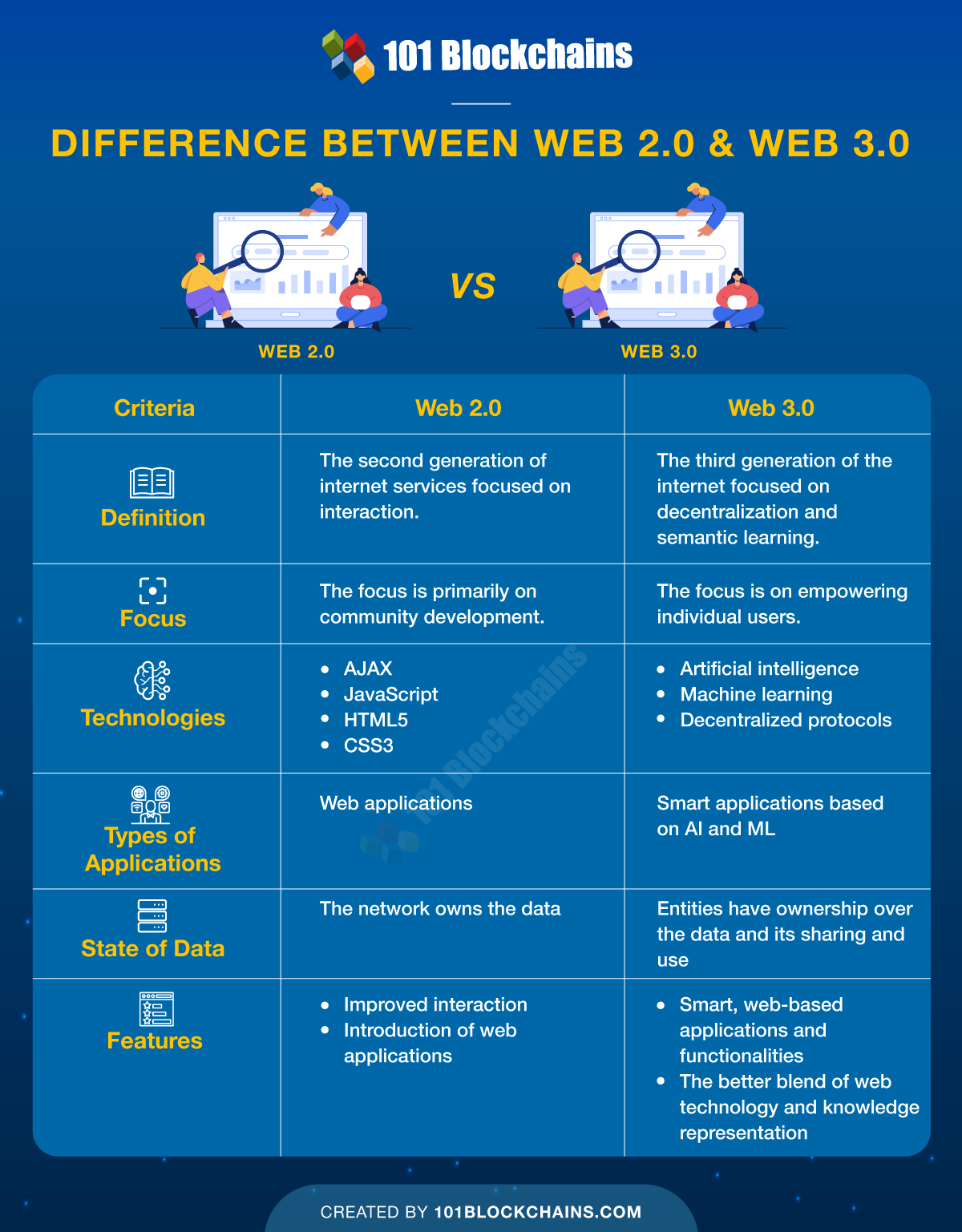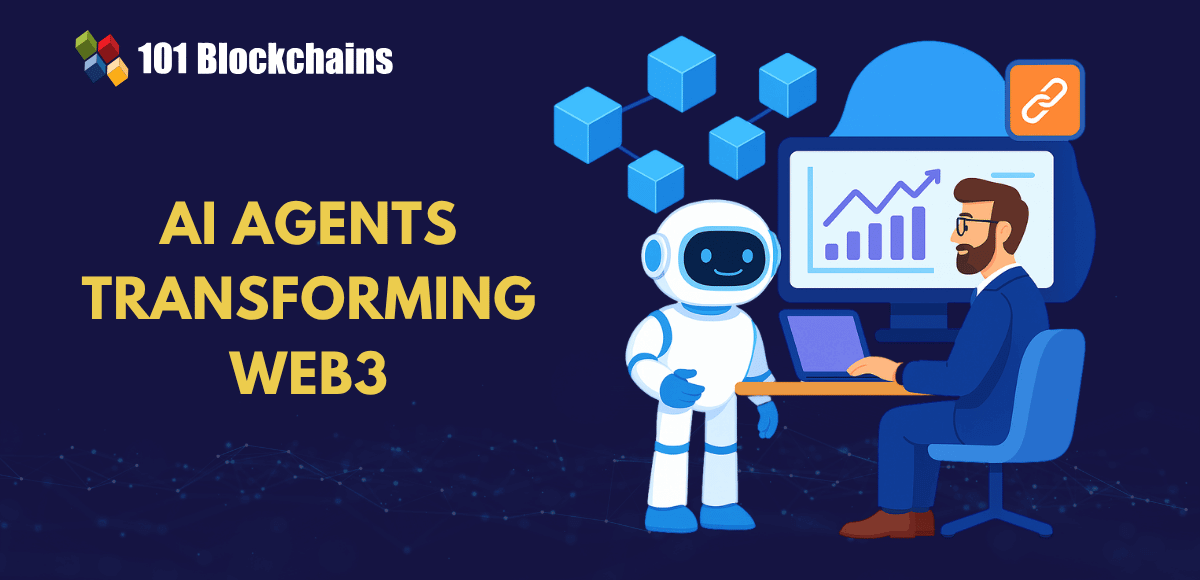Learn how blockchain truly works, master key definitions, and uncover what makes smart contracts so "smart." Dive into the fundamentals, gain valuable insights, and start your blockchain journey today!

- Comparisons
Diego Geroni
- on November 23, 2021
Difference between Web 2.0 and Web 3.0
Confused while understanding Web 2.0 and Web 3.0 differences? Here’re the significant differences between Web 2.0 and Web 3.0 you need to understand i.e. web 2.0 vs Web 3.0.
If you are following the world of blockchain closely, then you must have come across the terms “Web 2.0” and “Web 3.0”. You might be wondering about the exact definition of these terms and how they are relevant to the blockchain. The internet, as we know it, has been through many milestones before reaching the stage it is in now. Web 2.0 and Web 3.0 are generations of internet services with distinct variations in how users interact with the internet. Therefore, people are eager to find out about Web 2.0 and Web 3.0 differences to know why they need Web 3.0. The following discussion would help you discover the distinct traits of Web 2.0 and Web 3.0 in detail. A detailed understanding of Web 2.0 and Web 3.0 would set the ideal foundation for reflecting on the Web 2.0 vs Web 3.0 comparison.
Evolution of the Web
The internet has evolved in different phases over the years since the time it was created. In the first phase, we had Web 1.0 which included static web pages which served content from the file system of servers. Web 1.0 allowed internet users to access data from almost any corner of the world. However, Web 1.0 did not offer any functionalities for interaction with the content. As a result, web 2.0 started to gain prominence and the subsequent identification of setbacks in Web 2.0 led to the development of web 3.0. Let us learn about Web 2.0 and Web 3.0 before finding the answer to “What is the difference between Web 2.0 and Web 3.0?” for understanding the differences effectively.
What is Web 2.0?
If you want to learn about the Web 2.0 vs Web 3.0 comparison in detail, then you should start with Web 2.0. It refers to the second generation of internet services, which focused on enabling users to interact with content on the web. Web 2.0 fostered the growth of user-generated content alongside interoperability and usability for end users. The second-generation web does not focus on modifying any technical specifications. On the contrary, it emphasizes changing the design of web pages and the ways of using them. Web 2.0 encouraged collaboration and interaction among users in P2P transactions, thereby setting the stage for e-commerce and social media platforms.
Apart from the favorable implications of interoperability, interactivity, and usability, web 2.0 also fosters interoperability across various services. Another important highlight about Web 2.0 in the Web 2.0 and Web 3.0 differences would refer to web browser technologies. AJAX and JavaScript have emerged as formidable instruments for the creation of Web 2.0 websites.
Build your identity as a certified blockchain expert with 101 Blockchains’ Blockchain Certifications designed to provide enhanced career prospects.
Features of Web 2.0
It is also important to understand the distinctive features of Web 2.0 for a precise impression of Web 2.0 vs Web 3.0. Here are some of the notable traits you can identify with Web 2.0.
- Web 2.0 enables free information sorting thereby enabling users to collectively retrieve and classify the information.
- The second generation of internet services also focuses on ensuring dynamic content with high responsiveness to user inputs.
- Web 2.0 also emphasizes evaluation and online commenting as channels for information flow between site users and site owners.
- Web 2.0 enabled access to web content from televisions, mobile devices, multimedia consoles, and almost any internet-connected device.
- Most important of all, web 2.0 is also referred to as a participative social web. Users could now participate in the creation and sharing of responsive content alongside presenting favorable prospects for collaboration. Therefore, one can clearly notice how Web 2.0 is vital in encouraging the growth of new virtual communities.
With a distinct assortment of features, you can move ahead with Web 2.0 vs Web 3.0 through an outline of the uses of Web 2.0. You could discover a wide range of online tools and portals which can allow people to share their experiences, perspectives, thoughts, and opinions. Web 2.0 applications have showcased a formidable frontend revolution with more opportunities for interaction with the end users. Users could find a wide range of applications in Web 2.0 for different applications. Some of them include social media, blogging, web content voting, social bookmarking, podcasting, and tagging.
Build your fluency in Web3 and develop decentralized solutions with the world’s first Web3 Expert Career Path with quality resources tailored by industry experts Now!
What is Web 3.0?
While Web 2.0 might look like an advanced approach to the internet, it still harbors many setbacks. What about the security of your personal data? Trusted institutions take control over the data of users in Web 2.0, especially due to the need for trusted intermediaries. If two parties want to complete a transaction and they don’t know or trust each other, then they would have to rely on trusted intermediaries. However, the intermediary has control over the data storage and management thereby strengthening their grip over users. In addition, centralized power has never gone well in times of crisis thereby calling for decentralization. The latter player in the question of “What is the difference between web 2.0 and web 3.0?” has a promising solution to the setbacks in web 2.0.
Web 3.0 presents a promising improvement over Web 2.0, especially with major transformations in terms of infrastructure. Also referred to as the semantic web, the third generation of the web leverages an advanced metadata system. The metadata system helps in structuring and arranging all types of data for making it readable for humans and machines. The foremost advantage associated with Web 3.0 is practically the best highlight in Web 2.0 and Web 3.0 differences. Web 3.0 takes away the need for centralized intermediaries and introduced the universality of information.
Curious to develop an in-depth understanding of web3 application architecture? Join Yearly/Yearly+ Plan and Enroll Now in Web3 Application Development Course!
How Web 3.0 is Revolutionary?
The understanding of Web 2.0 vs Web 3.0 comparison should also focus on the uniqueness of Web 3.0. The third iteration of the web presents one formidable answer to setbacks of Web 2.0 with an emphasis on innovative technologies. Web 3.0 leverages artificial intelligence for powering machine-to-machine interaction alongside advanced analytics. In addition, Web 3.0 also uses a decentralized network for passing data to the control of owners. As a result, users get the opportunity for exerting ownership of their data alongside determining the ways in which it should be shared. Furthermore, the web 2.0 and Web 3.0 differences would also focus on improved privacy and security for users. Web 3.0 leverages encryption and distributed ledger technology for resolving the concerns of trust, which were evident in Web 2.0.
Noticeable Features of Web 3.0
You can build a stronger foundation for understanding “What is the difference between Web 2.0 and Web 3.0?” by focusing on the features of Web 3.0 also. Here are some of the crucial highlights of Web 3.0 which would help in differentiating it from Web 2.0.
- Web 3.0 leverages artificial intelligence to offer correct results at a faster pace alongside accessing real-time insights.
- Web 3.0 also enables users to capitalize on the potential of 3D visuals and graphics.
- Another critical feature of Web 3.0 refers to the Semantic Web functionality. It implies that Web 3.0 could support understanding the meaning of words. As a result, machines and humans could easily find, share and analyze information in Web 3.0.
- You can also find the prominent trait of improved privacy and security in Web 3.0.
- The Web 2.0 and Web 3.0 differences would also focus on the safeguards for user data and identity. Web 3.0 employs advanced authorization mechanisms through distributed ledger technologies and encryption for securing user identity and data.
Curious to know whether web 3.0 will play an important part in the future of the internet? Check the detailed guide Now on The Insane Future Of Web3
Comparison between Web 2.0 and Web 3.0

Please include attribution to 101blockchains.com with this graphic. <a href='https://101blockchains.com/blockchain-infographics/'> <img src='https://101blockchains.com/wp-content/uploads/2021/11/Difference-Between-Web-2.0-Web-3.0.png' alt='Difference Between Web 2.0 and Web3.0='0' /> </a>
The detailed impression of Web 2.0 and Web 3.0 alongside their features clearly showcase the differences between them. For example, you can notice that Web 2.0 is all about read-and-write operations while Web 3.0 is driving emphasis on the semantic web. Let us take a look at the web 2.0 vs web 3.0 comparison with respect to different factors as follows.
-
Definition
One of the foremost factors to answer “What is the difference between web 2.0 and web 3.0?” would focus on their definitions. Web 2.0 is the participative social web or the second generation of internet services that enable read-and-write functionalities. On the other hand, Web 3.0 is the third generation of the web which focuses on the semantic web. It basically focuses on enabling better communication and understanding between users and machines in decentralized infrastructures.
-
Focus
The next critical aspect for identifying web 2.0 and web 3.0 differences would obviously draw attention toward the primary focus. Web 2.0 focused on enabling users to interact with content on the internet. On the other hand, Web 3.0 fosters immersion in the content on the internet by becoming an active contributor. While Web 2.0 aimed to connect people, web 3.0 aims to connect knowledge. On a broader level, the focus of Web 2.0 reflected largely on tagging and end-user experiences. Web 3.0 turned its focus towards user empowerment by facilitating improved trust, security, and privacy. So, you could clearly identify that the focus area is a notable aspect in web 2.0 vs. web 3.0 comparisons. You have Web 2.0 focusing particularly on community development while Web 3.0 intends to empower individuals.
Curious to gain more insights and clarity regarding the potential of web3? Check the detailed guide SmartNow on Frequently Asked Questions About Web3
-
Technologies
The third important differentiating factor in the Web 2.0 vs Web 3.0 comparison would refer to the underlying technologies. Web 2.0 has played a decisive role in fostering the development of many new technologies. Some of the notable technologies underlying the growth of Web 2.0 include AJAX and JavaScript. In addition, you can also notice the dominance of CSS3 and HTML5 among the technologies empowering Web 2.0. On the other hand of the spectrum, you can find Web 3.0 providing support for the implementation of innovative technologies. The major technologies underpinning the foundation of Web 3.0 include AI, the semantic web, and decentralized protocols. The other notable technologies underlying the growth of Web 3.0 include knowledge bases and ontologies.
-
Types of Applications
Another crucial factor for answering “What is the difference between web 2.0 and web 3.0?” would refer to the types of applications associated with them. In the case of Web 2.0, you can find web applications. Some examples of Web 2.0 applications include two-way web pages, video websites, podcasts, and personal blogs. On the contrary, web 3.0 empowers the growth of smart applications with capabilities for leveraging ML and AI functionalities. The notable examples of Web 3.0 applications might include multi-user virtual environments, 3D portals, and integrated games.
-
State of Data
The state of data is also another prominent factor in the outline of Web 2.0 and Web 3.0 differences. In the case of Web 2.0, the network takes ownership of the data. However, web 3.0 implies the ownership of data by an entity alongside flexibility for sharing data throughout the network.
-
Features
The final highlight for the Web 2.0 vs Web 3.0 comparison would obviously highlight the features. Web 2.0 allows better interaction alongside introducing a wide range of web applications. In addition, it also relies on interactive advertising. On the other hand, web 3.0 relies on behavioral marketing and offers smart, web-based functionalities and applications. As a matter of fact, web 3.0 offers a perfect representation of the blend between web technology and knowledge representation.
Learn the fundamentals, challenges and use cases of Web3.0 blockchain from the E-book: AN INTRODUCTION TO WEB 3.0 BLOCKCHAIN
Final Words
The clear observation of highlights in the Web 2.0 vs Web 3.0 comparison shows how it presents better advantages than Web 2.0. It presents a promising infrastructure required for the interaction between humans and machines. Most important of all, web 3.0 comes with better security, trust, and privacy. Many people also consider Web 3.0 as the decentralized web, which will be largely based on decentralized protocols. On the other hand, web 2.0 is still the common foundation for many web applications we use today. Could Web 3.0 revolutionize the popular applications you are using today? Learn about Web 3.0 and find out yourself.
If you want to know everything about blockchain and related technology, you must enroll for blockchain certifications and courses!






